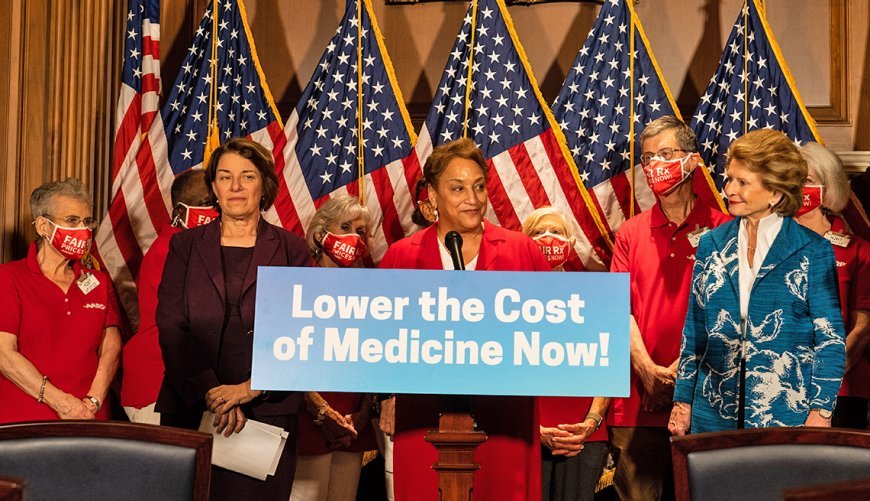The U.S. Senate passed a historic budget bill on Aug. 7 that would help millions of Medicare enrollees better afford their life-sustaining medications and help millions more Americans pay their Affordable Care Act (ACA) health insurance premiums. The measure must now be approved by the House of Representatives before going to the president’s desk.
“Thanks to today’s historic vote in the Senate, millions of Americans 50-plus are one step closer to real relief from out-of-control prescription drug prices,” AARP CEO Jo Ann Jenkins said in a statement after the Senate vote. “Since AARP’s founding we have fought for older adults to have access to affordable health care — including prescription drugs. And we have been working for nearly two decades to allow Medicare to negotiate the price it pays for medications.”
The Inflation Reduction Act of 2022 passed 50 to 50 with Vice President Kamala Harris casting the tie-breaking vote. Quick action is anticipated in the House, and President Joe Biden has said he would sign the legislation, which includes some elements of the Build Back Better package the House passed late in 2021. Democrats used a budget procedure called reconciliation that allowed the bill to be passed with a simple majority and not subject to a filibuster.
The measure for the first time would authorize Medicare to negotiate the prices of some high-cost prescription drugs with pharmaceutical companies, put an annual $2,000 limit on how much Part D prescription drug plan members would have to pay out of pocket for their medications, and levy tax penalties on drugmakers that increase the prices of their products more than the rate of inflation. The bill also would cap the cost of Medicare-covered insulin at $35 a month and eliminate out-of-pocket costs for most vaccines under Medicare.
The legislation would save Medicare hundreds of billions of dollars over 10 years, with the majority of the savings coming as a result of prescription drug price negotiations and the rebates that would encourage pharmaceutical companies to keep price increases to no more than the rate of inflation, according to an analysis by the nonpartisan Congressional Budget Office. That means beneficiaries would be able to get the same medications they do now, but some of those drugs would cost them and Medicare less. The savings would not be the result of any cuts to the Medicare program.
“Since AARP’s founding we have fought for older adults to have access to affordable health care — including prescription drugs.”
— Jo Ann Jenkins, AARP CEO
Also included is a three-year extension of the expanded subsidies and other financial enhancements first included in the American Rescue Plan that help bring down the costs of ACA health insurance plans. These subsidies are particularly important to those ages 50 to 64, who pay up to three times more for their insurance.
The sweeping bill would also invest in energy and climate change and make a number of corporate tax law changes.
“Lowering prescription drug prices is a top priority for Americans, with more than 80 percent of people from both political parties supporting the measure,” Jenkins said. “AARP fought hard for this victory, and we will keep fighting to get Americans relief from the high price of prescription drugs. We urge the House to move quickly and enact this momentous reform.”
Here are the main elements of the health care portions of the bill.
Part D changes
- For the first time, out-of-pocket costs for Part D prescription drugs would be capped. Starting in 2025, beneficiaries would not have to pay more than $2,000 a year for their share of Part D drugs.
- Beginning in January, most vaccines would be free in Medicare.
- Part D premiums could not increase more than 6 percent a year through at least 2029. The income threshold for beneficiaries to qualify for a subsidy to help pay for Part D out-of-pocket costs would be increased from 135 percent of the federal poverty level ($18,347 for an individual in 2022) to 150 percent ($20,385 for an individual in 2022).
Negotiating drug prices
The Health and Human Services secretary would be authorized to begin negotiating the prices of 10 high-cost prescription drugs in 2023, and the negotiated prices would go into effect in 2026 for Medicare Part D medications and 2028 for drugs covered under Medicare Part B. The number of drugs whose prices would be negotiated on behalf of Medicare would increase in subsequent years, and by 2029 a total of 60 drugs would be subject to negotiated prices.
Inflation rebate
Beginning in October of this year, if the price of a Part D prescription drug is raised more than the rate of general inflation, the drugmaker would have to rebate Medicare the amount of the increase that is higher than the inflation rate. Rebates for higher-than-inflation price hikes for medications covered under Medicare Part B (usually office-based infusions, such as for cancer drugs) would begin in January.
ACA subsidies extended
For people who buy their health insurance through the ACA marketplaces, the bill would extend the federal premium subsidy and other financial enhancements made under the American Rescue Plan through 2025. For those 50 to 64 years of age, these subsidies provide an average savings of over $950 annually, and all consumers would continue to pay no more than 8.5 percent of their income on ACA health insurance premiums.
Editor’s note: This story has been updated with new information.
Dena Bunis covers Medicare, health care, health policy and Congress. She also writes the Medicare Made Easy column for the AARP Bulletin. An award-winning journalist, Bunis spent decades working for metropolitan daily newspapers, including stints as Washington bureau chief for the Orange County Register and as a health policy and workplace writer for Newsday.



